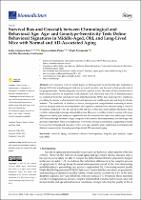| dc.contributor | Vall d'Hebron Barcelona Hospital Campus |
| dc.contributor.author | Marin-Pardo, Daniela |
| dc.contributor.author | Marazuela Fuentes, Paula |
| dc.contributor.author | Hernandez Guillamon, Maria Mar |
| dc.contributor.author | Giménez-Llort, Lydia |
| dc.date.accessioned | 2022-02-25T13:46:12Z |
| dc.date.available | 2022-02-25T13:46:12Z |
| dc.date.issued | 2021-06 |
| dc.identifier.citation | Giménez-Llort L, Marin-Pardo D, Marazuela P, Hernández-Guillamón M. Survival Bias and Crosstalk between Chronological and Behavioral Age: Age- and Genotype-Sensitivity Tests Define Behavioral Signatures in Middle-Aged, Old, and Long-Lived Mice with Normal and AD-Associated Aging. Biomedicines. 2021 Jun;9(6):636. |
| dc.identifier.issn | 2227-9059 |
| dc.identifier.uri | https://hdl.handle.net/11351/7093 |
| dc.description | Alzheimer’s disease; Aging; Survival |
| dc.description.abstract | New evidence refers to a high degree of heterogeneity in normal but also Alzheimer’s disease (AD) clinical and temporal patterns, increased mortality, and the need to find specific end-of-life prognosticators. This heterogeneity is scarcely explored in very old male AD mice models due to their reduced survival. In the present work, using 915 (432 APP23 and 483 C57BL/6 littermates) mice, we confirmed the better survival curves in male than female APP23 mice and respective wildtypes, providing the chance to characterize behavioral signatures in middle-aged, old, and long-lived male animals. The sensitivity of a battery of seven paradigms for comprehensive screening of motor (activity and gait analysis), neuropsychiatric and cognitive symptoms was analyzed using a cohort of 56 animals, composed of 12-, 18- and 24-month-old male APP23 mice and wildtype littermates. Most variables analyzed detected age-related differences. However, variables related to coping with stress, thigmotaxis, frailty, gait, and poor cognition better discriminated the behavioral phenotype of male APP23 mice through the three old ages compared with controls. Most importantly, non-linear age- and genotype-dependent behavioral signatures were found in long-lived animals, suggesting crosstalk between chronological and biological/behavioral ages useful to study underlying mechanisms and distinct compensations through physiological and AD-associated aging. |
| dc.language.iso | eng |
| dc.publisher | MDPI |
| dc.relation.ispartofseries | Biomedicines;9(6) |
| dc.rights | Attribution 4.0 International |
| dc.rights.uri | http://creativecommons.org/licenses/by/4.0/ |
| dc.source | Scientia |
| dc.subject | Ratolins |
| dc.subject | Alzheimer, Malaltia d' - Mortalitat |
| dc.subject.mesh | Mice |
| dc.subject.mesh | Alzheimer Disease |
| dc.subject.mesh | /mortality |
| dc.title | Survival Bias and Crosstalk between Chronological and Behavioral Age: Age- and Genotype-Sensitivity Tests Define Behavioral Signatures in Middle-Aged, Old, and Long-Lived Mice with Normal and AD-Associated Aging |
| dc.type | info:eu-repo/semantics/article |
| dc.identifier.doi | 10.3390/biomedicines9060636 |
| dc.subject.decs | ratones |
| dc.subject.decs | enfermedad de Alzheimer |
| dc.subject.decs | /mortalidad |
| dc.relation.publishversion | https://doi.org/10.3390/biomedicines9060636 |
| dc.type.version | info:eu-repo/semantics/publishedVersion |
| dc.audience | Professionals |
| dc.contributor.organismes | Institut Català de la Salut |
| dc.contributor.authoraffiliation | [Giménez-Llort L, Marin-Pardo D] Institut de Neurociències, Universitat Autònoma de Barcelona, Bellaterra, Spain. Departament de Psiquiatria i Medicina Forense, Escola de Medicina, Universitat Autònoma de Barcelona, Bellaterra, Spain. [Marazuela P, Hernández-Guillamón M] Vall d’Hebron Institut de Recerca (VHIR), Barcelona, Spain |
| dc.identifier.pmid | 34199476 |
| dc.identifier.wos | 000666650900001 |
| dc.relation.projectid | info:eu-repo/grantAgreement/ES/PE2013-2016/RD16%2F0019/%2F0021 |
| dc.rights.accessrights | info:eu-repo/semantics/openAccess |

